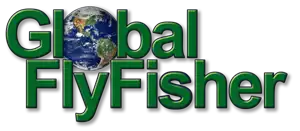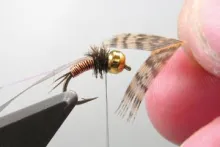John Barr
Nymph
A little difficult
- Run the bead over the hook point with the large hole to the rear
- Cover the front bit of the hook with tying thread for the bead to fit tightly
- Whip finish and cut thread
- Varnish or glue the bead in position over the thread base in the absolute front of the hook
- Add a few wraps of heavy wire to the shank and shove into the rear opening of the bead
- Start the copper wire right behind this wire and run it in tight turns to the rear of the hook
- Cover the whole thing with tying thread to secure it. Make sure the thread is as even as possible
- Prepare two goose biots and tie in as tails on each side of the hook
- Run the thread back to behind the bead and follow by the copper wire in tight, even turns
- Tie down the copper and break off surplus
- Tie in a piece of flash straw on top of the hook
- Tie in shell back on top of this
- Tie in 1-3 peacock herls depending on hook size
- Wind the herl forwards to form a thorax
- Tie down and trim
- Prepare a partridge feather by removing the tip to form a V-shape
- Tie it in to form legs protruding from the side of the fly
- Trim surplus feather
- Pull shell back and flash forwards and tie down
- Whip fishing and cut tying thread
- Cover the shell back and upper body with epoxy
brown trout
chub
| Hook | Curved nymph hook size 14-20 |
| Thread | Black 8/0 |
| Bead | Brass bead to suit hook |
| Extra weight | Heavy wire for extra weight |
| Body | Copper wire |
| Tail | Black goose biots |
| Back | Expoxy |
| Thorax | Peacock herl |
| Legs | Partridge feather |


